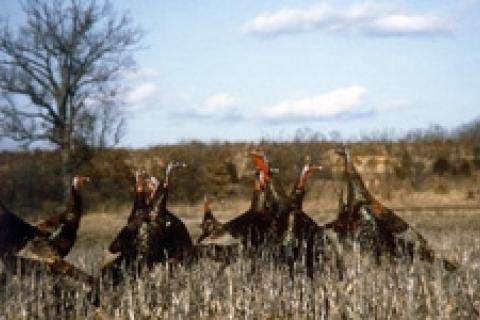
"Ghosts of the autumn woods" is how RedHead Pro Hunting Team member Walter Parrott describes fall turkeys.
I spent some time one Sunday afternoon in late August talking with Walter to get his views and ideas about fall turkey hunting. To say Parrott knows turkeys is a bit of an understatement.
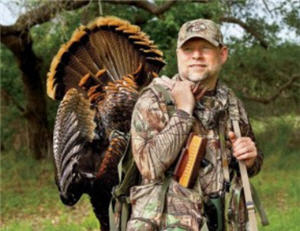 |
| RedHead Pro Hunting Team member Walter Parrott |
Parrott has won more major turkey calling championships than anyone in the world and he's the only person to win every major turkey calling contest. The list of championships is impressive: 5-time World Champion, 5-time Grand National Champion, 3-time Team Grand National Champion, Grand National Champion of Champions, 16-time U.S. Open Champion (Open Division, Friction and Champion of Champions) and has won World, The Masters, Mid-America Open and many state and local competitions. And, his numerous seminars, appearances and videos have educated tens of thousands of turkey hunters and outdoorsmen.
![]() Tip: Shop Turkey Calls at Bass Pro Shops here
Tip: Shop Turkey Calls at Bass Pro Shops here
Talking Turkey With Walter Parrott
"Lots of hunters think fall turkeys are difficult to hunt because they believe the myth that turkeys are not as vocal in the fall," Parrott began. "Those guys are tuned in to the gobble of the wild turkey tom. True, they don't sound off like they do in the spring, but there are still plenty of turkey sounds to be heard in the fall woods."
"As a result of gobblers not sounding off in fall," Parrott says, "fewer hunters pursue fall turkeys because the birds can be far more difficult to locate."
"A prime factor that sets the tone for fall turkey hunting tactics is the fact that a flock of 25 turkeys has 50 of the best eyes you will ever find in the woods," Parrott lamented. "All I attempt to do (in contest calling) is get judges to listen. With wild turkeys I have to scout, interpret sign, use my woodsmanship skills, locate birds, interpret their mood, sometimes scatter a flock and then attempt to call in a fashion that will convince the birds that they want to share my company."
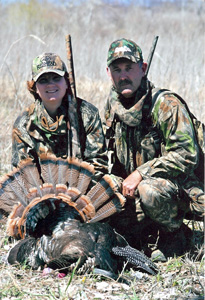 And hunting the real ghosts of fall — old gobblers — is the most challenging scenario of all.
And hunting the real ghosts of fall — old gobblers — is the most challenging scenario of all.
"Fall gobblers are tough," Parrott said. "Gobblers don't sound off much in the fall and they often slip in and out silently. "Their ability to appear out of nowhere and vanish into thin air just as quickly would make Casper jealous."
Parrott's tactics for mature fall gobblers are simple. "Use raspy clucks and plenty of stealth. Listen a lot and plan on burning lots of shoe leather."
"Food sources," Parrott emphasized, "are one of the most important finds fall turkey hunters can make. Finding food sources that are available to large flocks of birds is a primary tactic for consistently being successful at harvesting turkeys in the fall."
Parrott pointed out that turkeys spend the summer months chasing grasshoppers and other insects. That food source only lasts until the first heavy frost. Flocks will then begin to look for other food sources. In the heavily forested areas of the Midwest that means one thing: acorns.
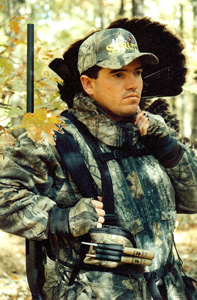 |
| Carry as many calls as you can to sound like a bunch of different turkeys. |
"Knowing where the best acorn producing trees are in a given area is a great tactic to eliminate a lot of non-productive territory," says Parrott. "And if you aren't up to date on the quality of the acorn crop in the area you plan to hunt, call the local conservation agent or US Forest Service office. They can tell you about the status of the acorn crop."
Knowing your oak trees can pay off as well. White oaks bear acorns every season, unless a late frost wipes out the crop in the spring. It takes black oaks two seasons to bear a crop of acorns. As a result, black oak acorns often fill in the gap when the white oak acorn crop fails. Turkeys prefer white oak acorns, but will readily feed on back oak acorns.
After locating food sources, Parrott then scouts nearby areas thoroughly for other turkey sign. Scratchings in the leaves, droppings and discarded feathers are prime indicators of turkey activity in an area.
"Early morning and late afternoon are the best times to listen in the fall because that is when the flocks are leaving the roost and going to roost," Parrott instructed. "Those two time periods are when fall flocks are the most vocal. I call it the 'chicken house effect' because the flocks often sound like a hen house full of excited chickens."
Parrott's favorite fall turkey hunting tactic is to flush birds from the roost. "Doing so creates the ideal fall turkey hunting scenario."
"I first try to locate roosting flocks with soft tree yelps, if they are not already vocal. I try to get them to come to me. If they don't, I simply begin easing closer. Once I spot birds in the trees, I begin yelling and beating on trees with a stick. I don't over-do it. There is a difference between scattering the birds and scaring them into the next county."
Parrott sits down near the scatter point and lets the turkeys dictate the pace. As soon as he hears a poult's "kee-kee" call, he begins to call, using both the assembly call and the calls of a dominant hen. But don't wait too long, Parrott warns. The result is a lost flock; experienced hens can reassemble their poults in a hurry.
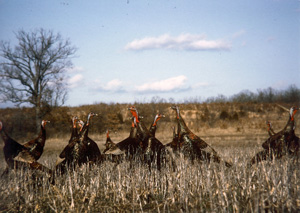 |
| Hunting fall turkeys in open areas can be tough. Knowing their travel routine and using decoys are two good hunting strategies. |
"Two of the most common difficult scenarios hunters face in the turkey woods," Parrott pointed out, "are finding turkeys already off the roost and locating flocks with an obstacle in the way. When I locate flocks on the ground, I lay my gun down on my hunter orange vest, so I can find it again, and run at the turkeys to scatter them. Hearing turkeys across a big valley or a stream, or on the other side of thick cover, presents a challenge that takes ingenuity and stamina to overcome. Knowing where the turkeys are headed is paramount. Remember those food sources, then, it is simply a matter of heading the flock off and setting up to scatter the flock or attempt to call them."
Hunting open areas, such as plains or large crop fields present special challenges, according to Parrott. "A good set of binoculars are a must under these conditions," Parrott said. "You can scan a lot of territory in a hurry. "
"Knowing a flock's daily travel routine can save a lot of frustration. Using turkey decoys is also a good tactic because turkeys can see them from a long way off in those big, open areas. Challenging a dominant hen may just cause her to come over to investigate. And where mama goes, everybody goes." Parrott added.
A final tip which Parrot shared about hunting fall turkey comes from a tactic he learned a long time ago from turkey hunting legend Ben Lee.
"Ben would take a cheap dime-store plastic whistle and remove the ball," Parrott said. "Saying the words 'pee, pee, pee' into the empty whistle shell imitates beautifully the kee-kee of young fall turkeys."
Standing high on a wooded ridge at daybreak, with fresh fall air blowing on your face and listening to the cackles, clucks and kee-kees of a flock of turkeys trying to reassemble after fly down is exhilarating. Toss in the dramatic colors of fall foliage and the company of a good friend and you have the makings of the perfect fall turkey hunt.
"'Oh, P.S.," Parrott said. "I always carry as many turkey calls as I can to sound like a bunch of different turkeys. Turkey box calls, slates, glass, push-pulls, mouth and tube calls — they all pull those ghosts of the autumn woods to the gun."
- 12662 views

